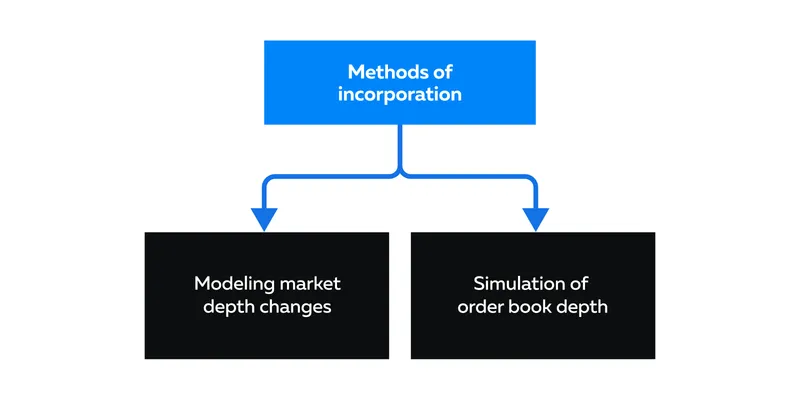Ready to see the market clearly?
Sign up now and make smarter trades today
Education
January 10, 2024
SHARE
Leveraging Depth-of-Market (DOM) Analysis for Effective Backtesting
The importance of real-time information cannot be undermined in the dynamic world of financial markets. Depth-of-market (DOM) provides traders with up-to-the-minute details about buy and sell orders placed at various price levels.
DOM is displayed in a price ladder form and is used by traders to gauge the current market depth and liquidity. Through this article, you will understand the importance of DOM, its benefits, and how using advanced market analysis tools like Bookmap, can help. Let’s get started.
Understanding DOM and Its Importance in Trading
Depth-of-Market (DOM) is traditionally presented through a price ladder interface, which provides real-time data about current buy and sell orders at various price levels. It helps traders in:
- Identifying key support and resistance levels
- Gauging potential price movements
- Making informed trading decisions based on order book dynamics
- Enhancing overall market analysis for more strategic trading
Common Challenges in Backtesting with Traditional DOM
While the price ladder interface is a valuable tool for live trading, it presents challenges for backtesting due to its real-time nature. Backtesting requires historical market data, and the traditional DOM format lacks this capability.
However, the concept of heatmaps has revolutionized DOM analysis for backtesting purposes. Heatmaps visualize historical market depth data, allowing traders to analyze past order book dynamics. Advanced market analysis tools like Bookmap offer intuitive heatmaps that offer historical DOM data for in-depth analysis and backtesting.
What Does DOM Data Reveal?
DOM data includes information about:
- Price levels
- Order sizes
- The potential direction of price moves
By studying these elements, traders can better anticipate short-term price movements. Also, by examining order sizes and price levels, traders gain a deeper understanding of the liquidity structure in the market.
DOM in Historical Backtesting
Backtesting relies on historical data to simulate and analyze trading strategies. Whereas Depth-of-Market (DOM) is a real-time feature and poses a challenge for traders engaged in historical backtesting.
Thus, it was essential to find ways to incorporate the dynamic nature of DOM into this process. This prompted traders to devise several methods to incorporate DOM in historical backtesting. Let’s understand them below.
Incorporating DOM in Backtesting: Methods, Considerations, and Pitfalls
The most common methods are:

Method 1: Simulation of Order Book Depth:
- Instead of relying solely on live DOM data, traders simulate order book depth.
- They recreate the market conditions during a specific historical period.
- This simulation involves reconstructing the order book as it would have appeared at different points in time.
Method 2: Modeling Market Depth Changes
- Traders analyze how market depth evolves by incorporating historical data into their backtesting models.
- This allows them to understand how order book dynamics influenced price movements in the past.
While incorporating historical DOM data, traders must consider the following:
- The accuracy of historical DOM data is paramount. Thus, traders need data that precisely reflects the order book at different time points.
- Traders must gather high-resolution data to ensure a detailed analysis of market depth changes.
- Traders should also carefully vet the source of historical DOM data to ensure its reliability.
Potential Pitfalls to Avoid – The Don’ts
| Don’t Overlook Data Timestamps | Don’t Neglect Order Book Dynamics |
|
|
Bookmap’s Zoom Out Feature & DOM Insight
Advanced market analysis tools like Bookmap, offer a powerful zoom-out feature. It is a powerful tool that enhances traders’ ability to visualize market depth over longer periods. Unlike traditional Depth-of-Market (DOM) interfaces Bookmap’s zoom-out feature:
- Provides a comprehensive view of historical liquidity,
- Helps traders to analyze market dynamics in a broader context.
Let’s understand this feature in detail.
How Does the Zoom Out Feature in Bookmap Help?
- Helps in Gaining Historical Perspective:
-
-
- By zooming out, traders can observe how market depth and liquidity have evolved over extended time frames.
- This historical perspective is invaluable for understanding:
- Market trends and,
- Effectiveness of trading strategies over time.
-
- Identifies Patterns and Trends:
-
- Analyzing historical liquidity patterns helps traders identify trends and recurring behaviors in the order book.
- This insight is crucial for making informed decisions during both backtesting and live trading.
How to Integrate DOM Analysis with Bookmap’s Zoom Out Feature in Backtesting
Follow these steps to achieve successful integration:
| Steps | Explanation |
| Acquire Historical Data |
|
| Import Data into Bookmap |
|
| Activate Zoom Out Feature |
|
| Analyze Liquidity Dynamics |
|
| Extract Insights for Backtesting |
|
By incorporating Bookmap’s zoom-out feature into your backtesting routine, you enhance your ability to make well-informed trading decisions based on a comprehensive analysis of market depth over extended periods.
Integrating DOM with Other Backtesting Components
Depth-of-market (DOM) data plays a complementary role alongside other technical and fundamental analysis tools during backtesting. While price charts, volume analysis, and economic indicators offer valuable insights, DOM data provides a granular view of market dynamics. Let’s understand some common strategies for incorporating DOM analysis.
Strategies for Incorporating DOM Analysis
Practice the following strategies to use DOM analysis alongside price charts, volume analysis, and economic indicators.
Strategy 1. Price Chart Synchronization:
- Overlay DOM on price charts
- Displaying DOM data alongside price charts allows traders to correlate order book dynamics with price movements.
- This integration aids in identifying key support and resistance levels, as well as potential reversal points.
Strategy 2. Volume Analysis Integration:
- Correlate order sizes with volume
- Combining DOM analysis with volume data helps traders assess the significance of order sizes.
- High order book liquidity coupled with substantial volume can signal strong support or resistance levels.
Common Mixed-Method Backtesting Approaches:
| What are the different approaches? | What do the traders do? | How does it help traders? |
| Combining Trend Analysis with DOM | Traders merge conventional trend analysis tools with Depth-of-Market (DOM). | Forming such a combination confirms signals with DOM data.
For example:
|
| Identifying Range-Bound Conditions | Traders spot range-bound conditions, occurring when price movements demonstrate lateral or sideways patterns within a specific trading range. | This identification helps in:
|
| Analyzing Order Book Response to News | Traders combine DOM analysis with news event data. | Traders understand how the order book reacts to market-moving news. |
Best Practices for DOM Analysis in Backtesting
Let’s understand the Do’s and Don’ts of factoring in DOM data:
The Do’s:
- Ensure that the historical DOM data used for backtesting is:
- Accurate
- High-resolution
- Reflective of real market conditions
- Gain a deep understanding of order flow dynamics.
- Identify patterns in order book movements and correlate them with price action.
- Integrate DOM analysis with other technical and fundamental tools.
- Simulate trading conditions as closely as possible to live markets. Consider factors like:
- Slippage
- Transaction costs
- Market impact
The Don’ts:
- Avoid using inaccurate or incomplete DOM data.
- Be cautious of overfitting strategies to historical DOM data.
- Ensure that your trading strategy is robust and not overly tailored to specific historical conditions that may not repeat.
- Understand how different market environments may influence order book dynamics and adjust your analysis accordingly.
- While backtesting, don’t overlook the psychological aspects of trading.
How to Interpret and Weigh DOM Information
Adapt the below strategies to correctly weigh DOM information and avoid common biases:
| Strategies | Steps to Implement |
| Focus on Key Levels |
|
| Watch for Imbalances |
|
| Consider Time Dynamics |
|
How to Track DOM Influences on Trade Outcomes
Most traders prefer record-keeping and resort to journaling methods to track DOM influences on trade outcomes. Let’s explore some common ones below:
- Document Observations:
-
-
- Maintain a detailed trading journal.
- Document observations from DOM analysis during backtesting.
- Note key insights, patterns, and any adjustments made to trading strategies based on DOM data.
-
- Track Influences on Trade Outcomes:
-
-
- Record how DOM information influences trade decisions and outcomes.
- This record-keeping helps in refining strategies over time.
- Learn from both successful and unsuccessful trades.
-
- Regularly Review Journal Entries:
-
- Periodically review your journal entries.
- Identify patterns in your decision-making process.
- This reflective practice contributes to continuous improvement in your trading approach.
Conclusion
Incorporating Depth-of-Market (DOM) analysis into backtesting provides traders with a nuanced understanding of market dynamics. This integration requires a combination of accurate data, diverse analysis tools, and a commitment to continuous learning. Traders who combine the information provided by the order book, alongside other analytical methods, are better equipped to refine their strategies for success.
The usage of modern market analysis tools loaded with advanced features helps traders in gaining a competitive edge. The Zoom-out feature of Bookmap helps in gaining historical perspective and identifying emerging patterns.
To put DOM analysis strategies into practice, Bookmap offers a comprehensive suite of tools for real-time and historical market depth examination. Unlock the potential of DOM in backtesting to refine your trading strategies. Start your journey with Bookmap today by signing up here.
